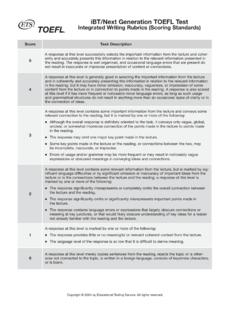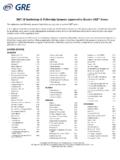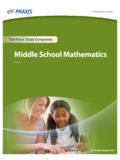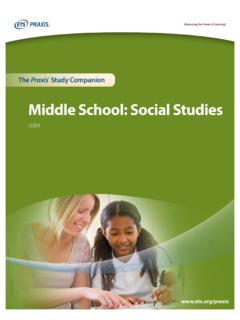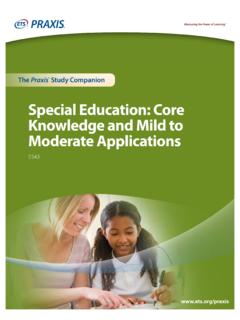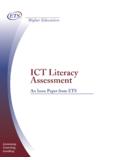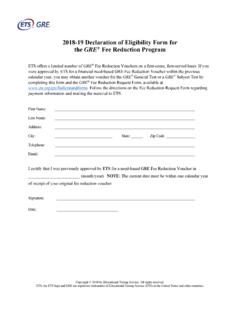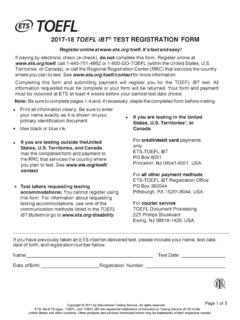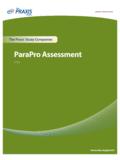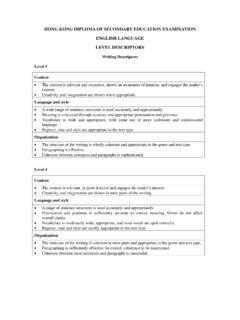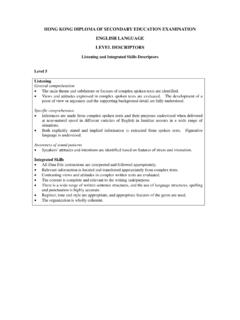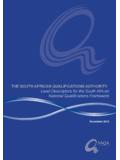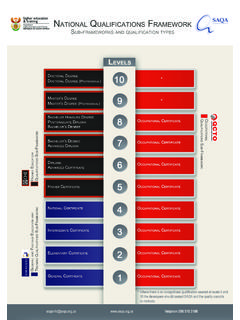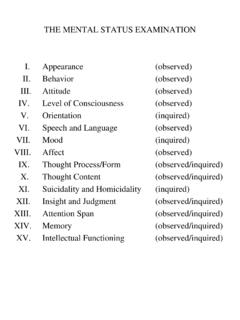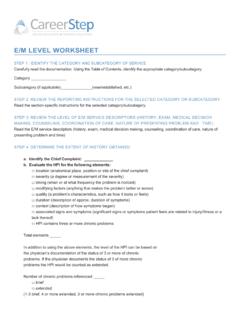Transcription of Level Strengths Weaknesses - Educational Testing …
1 TOEIC Listening Score Descriptors . Level Strengths Weaknesses 400 Test takers who score around 400 typically have the following Strengths : Test takers who receive a score at this Level typically have Weaknesses only when uncommon grammar or vocabulary is used. They can infer the central idea, purpose, and basic context of short spoken exchanges across a broad range of vocabulary, even when conversational responses are indirect or not easy to predict. They can infer the central idea, purpose, and basic context of extended spoken texts across a broad range of vocabulary. They can do this even when the information is not supported by repetition or paraphrase and when it is necessary to connect information across the text. They can understand details in short spoken exchanges, even when negative constructions are present, when the language is syntactically complex, or when difficult vocabulary is used. They can understand details in extended spoken texts, even when it is necessary to connect information across the text and when this information is not supported by repetition.
2 They can understand details when the information is paraphrased or when negative constructions are present. 300 Test takers who score around 300 typically have the following Strengths : Test takers who score around 300 typically have the following Weaknesses : They can sometimes infer the central idea, purpose, and basic context of They have difficulty understanding the central idea, purpose, and basic short spoken exchanges, especially when the vocabulary is not difficult. context of short spoken exchanges when conversational responses are They can understand the central idea, purpose, and basic context of indirect or difficult to predict or when the vocabulary is difficult. extended spoken texts when this information is supported by repetition They do not understand the central idea, purpose, and basic context or paraphrase. of extended spoken texts when it is necessary to connect information They can understand details in short spoken exchanges when easy or within the text or when difficult vocabulary is used.
3 Medium- Level vocabulary is used. They do not understand details in short spoken exchanges when They can understand details in extended spoken texts when the language is syntactically complex or when difficult vocabulary is information is supported by repetition and when the requested information used. They do not usually understand details that include negative comes at the beginning or end of the spoken text. They can understand constructions. details when the information is slightly paraphrased. They do not understand details in extended spoken texts when it is necessary to connect information across the text or when the information is not supported by repetition. They do not understand most paraphrased information or difficult grammatical constructions. 200 Test takers who score around 200 typically have the following Strengths : Test takers who score around 200 typically have the following Weaknesses : They can understand short (single-sentence) descriptions of the central They do not understand the central idea, purpose, or basic context idea of a photograph.
4 Of short spoken exchanges, even when the language is direct and no They can sometimes understand the central idea, purpose, and basic unexpected information is present. context of extended spoken texts when this information is supported by a They do not understand the central idea, purpose, and basic context lot of repetition and easy vocabulary. of extended spoken texts when it is necessary to connect information They can understand details in short spoken exchanges and descriptions across the text or when the vocabulary is somewhat difficult. of photographs when the vocabulary is easy and when there is only a They do not understand details in short spoken exchanges when small amount of text that must be understood. somewhat difficult vocabulary is used or when the language is They can understand details in extended spoken texts when the requested syntactically complex. They do not understand details that include information comes at the beginning or end of the text and when it negative constructions.
5 Matches the words in the spoken text. They do not understand details in extended spoken texts when the requested information is heard in the middle of the text. They do not understand paraphrased information or difficult grammatical constructions. Listening. Learning. Leading. Copyright 2007 by Educational Testing Service. All rights reserved. ETS, the ETS logo and TOEIC are registered trademarks of Educational Testing L I S T E N in g Service (ETS) in the United States of America and other countries throughout the world. Listening. Learning. Leading. is a trademark of ETS. 7080. TOEIC Reading Score Descriptors . Level Strengths Weaknesses 450 Test takers who score around 450 typically have the following Strengths : Test takers who score around 450 typically have Weaknesses only when the information tested is particularly dense or involves difficult vocabulary. They can infer the central idea and purpose of a written text, and they can make inferences about details.
6 They can read for meaning. They can understand factual information, even when it is paraphrased. They can connect information across an entire text, and they can make connections between two related texts. They can understand a broad range of vocabulary, unusual meanings of common words, and idiomatic usage. They can also make distinctions between the meanings of closely related words. They can understand rule-based grammatical structures. They can also understand difficult, complex, and uncommon grammatical constructions. 350 Test takers who score around 350 typically have the following Strengths : Test takers who score around 350 typically have the following Weaknesses : They can infer the central idea and purpose of a written text, and they can They do not connect information across a wide area within a text. make inferences about details. They do not consistently understand difficult vocabulary, unusual They can read for meaning.
7 They can understand factual information, meanings of common words, or idiomatic usage. They usually cannot even when it is paraphrased. make distinctions between the meanings of closely related words. They can connect information across a small area within a text, even when the vocabulary and grammar of the text are difficult. They can understand medium- Level vocabulary. They can sometimes understand difficult vocabulary in context, unusual meanings of common words, and idiomatic usage. They can understand rule-based grammatical structures. They can also understand difficult, complex, and uncommon grammatical constructions. 250 Test takers who score around 250 typically have the following Strengths : Test takers who score around 250 typically have the following Weaknesses : They can make simple inferences based on a limited amount of text. They do not understand inferences that require paraphrase or They can locate the correct answer to a factual question when the connecting information.
8 Language of the text matches the information that is required. They They have a very limited ability to understand factual information can sometimes answer a factual question when the answer is a simple expressed as a paraphrase using difficult vocabulary. They often paraphrase of the information in the text. depend on finding words and phrases in the text that match the same They can sometimes connect information within one or two sentences. words and phrases in the question. They can understand easy vocabulary, and they can sometimes They usually do not connect information beyond two sentences. understand medium- Level vocabulary. They do not understand difficult vocabulary, unusual meanings They can understand common, rule-based grammatical structures. of common words, or idiomatic usage. They usually cannot make They can make correct grammatical choices, even when other features distinctions between the meanings of closely related words.
9 Of language, such as difficult vocabulary or the need to connect They do not understand more-difficult, complex, or uncommon information, are present. grammatical constructions. 150 Test takers who score around 150 typically have the following Strengths : Test takers who score around 150 typically have the following Weaknesses : They can locate the correct answer to a factual question when not very They cannot make inferences about information in written texts. much reading is necessary and when the language of the text matches They do not understand paraphrased factual information. They rely on the information that is required. matching words and phrases in the text to answer questions. They can understand easy vocabulary and common phrases. They are often unable to connect information even within a single sentence. They can understand the most-common, rule-based grammatical They understand only a limited range of vocabulary.
10 Constructions when not very much reading is necessary. They do not understand even easy grammatical constructions when other language features, such as difficult vocabulary or the need to connect information, are also required. Listening. Learning. Leading. Copyright 2007 by Educational Testing Service. All rights reserved. ETS, the ETS logo and TOEIC are registered trademarks of Educational Testing Reading Service (ETS) in the United States of America and other countries throughout the world. Listening. Learning. Leading. is a trademark of ETS. 7076.
